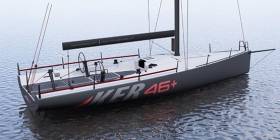Displaying items by tag: Ker46
Hull#1 of the new generation Ker46+ has been sold and will begin build later this month. The deal was signed last week at McConaghy's Zhuhai facility between the new owner Mr Shawn Kang and McConaghy's MD Mark Evans. Jason Ker was also on site for the signing, as was Wade Morgan who will act as the owners rep throughout the build.
The yacht will be raced by Shawn and his professional team, the yacht will be named Lighthorse, and fly the flag of the Royal Hong Kong Yacht Club (RHKYC).
Shawn said "I am excited we will soon be sailing this new and very fast, next generation Ker46+ . Having been sailing for many years our team is eager for more speed. With the new Ker46+ I believe team Lighthouse will be even more competitive on the water"
Mark Evans, MD of McConaghy said: "Shawn contacted us a few months ago about the Ker46, Jason and I had already spoken about updating the hull lines of the 46, so it was logical to offer the new package to Shawn. The yacht will have essentially the same deck as the first generation Ker46, but the hull shape and appendages are all new. So more tooling! But that's what it takes to stay ahead of the game, and that's what we do."
Jason Ker on the new design:
A lot has happened in the four years since we created the successful Ker46, of which four were built and raced successfully including class wins in the Sydney to Hobart race and many other race wins. Our continually improving optimisation technologies have been honed through various projects and it was clear that the time had come to bring out a new design. Replacing the Ker46 as our semi-custom offering in the size range, the Ker46+ uses as its generational baseline the heavily researched Ker40+ that came out guns-blazing in 2015 winning class in the Around the Island race on its first race outing and comfortably winning the first ever 'Fast 40' regatta.
Shape and Concept:
The Ker 46+ is significantly lighter than the previous generation, but its powerful hull form ensures excellent upwind and reaching performance. The hull shape is the product of an extensive formal optimisation involving large volumes of RANS CFD data, leveraged through use of Neural Networks and proprietary optimisation techniques. The optimisation process for the 46+ benefits from real data and feedback from our recent projects.
Structure:
Taking the structural optimisation to levels rarely seen outside of Americas Cup, the final lamination is the product of structural weight v stiffness optimisation, and the deflection of the shape under sailing loads is taken into account in the definition of the moulded shape. Construction is from pre-preg Carbon and carefully selected foams throughout; a large weight saving from the build method used on the infused Ker46 design.
The keel and mast support structure follows our tried and tested approach, built in the autoclave on machined aluminium moulds for reliability and accuracy.
Appendages:
An extensive keel shape optimisation has been carried out, achieving very significant section drag gains downwind without compromising upwind gains. These downwind gains have been used to increase the fin area, making the design easier to sail to its potential in variable conditions.
During recent years we have evolved our approach to keel fin structures, retaining our extremely cautious approach while taking advantage of extensive FEA structural optimisation and IRC's new freedom of keel fin material and processing selection to save considerable weight.
The rudder design uses an optimal blend of high modulus, intermediate modulus and standard modulus carbon fibre types to maximise its strength and stiffness within its design constraints, and is solid carbon right through its thickness in way of the critical lower bearing position.
Rig:
The rig aspect ratio is reduced compared to the previous 46, partly due to better sail depowering behaviour, reduced rig weight and better treatment by ORCi's aero model. The bowsprit length has increased significantly and the bowsprit design has been optimised for weight, stiffness, windage and reliability of installation.
Deck layout:
The 'coachroof' shape of the previous Ker 46 is retained, with its optimal jib sheeting arrangement on the apex of a long coachroof, however the jib tracks have been extended inboard to allow tighter sheeting angles. This arrangement allows for a more practical interior space for venturing offshore than the fully 'flat deck' arrangement that has become fashionable for inshore racing, but does so while actually saving weight through the incorporation of natural deck stiffeners into its shaping.
Record-Breaking Conditions Ahead for Fastnet Race
The largest, most diverse fleet of racing boats ever in offshore yachting set sail this morning in the Rolex Fastnet Race.
The biennial flagship event of the Royal Ocean Racing Club, a tradition since 1925, will take the fleet some 608 miles from Cowes on the Isle of Wight along the UK's south coast and across the Celtc Sea to Fastnet Rock off the Cork coastline, before returning past the Scilly Isles to the finish line at Plymouth.
An incredible 318 yachts are competing this year and they come in all shapes and sizes, from the 40m trimaran Maxi Banque Populaire to the 9.1m Rogers 30, Brightwork.
The majority of the fleet will be racing under the IRC for the Fastnet Challenge Cup, won by the crew that sails best to their rating. The weather will play a big part in this, as a fast start and slow finish favours bigger boats - so far today looks to be the opposite.
The 45-55 foot boats will surely provide the most competitive action, with past Fastnet winner Piet Vroon piloting his championship-leading Ker 46 Tonnere de Breskens towards another victory.
Fans of the Volvo Ocean Race will also be watching the race live tracker intently today, as this is one of the only times many of the competitors will line up together before the start of the round-the-world yachting challenge.
Regatta News has more on the story HERE.

























































